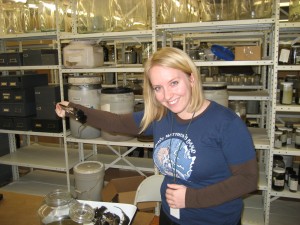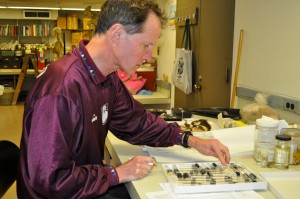
One of the giants of 20th century microbiology and evolutionary theory, Dr. Lynn Margulis of the University of Massachusetts at Amherst, died at age 73 this past Tuesday, Nov. 22nd. Margulis was a brilliant scientist and gifted writer who not only developed the important new evolutionary theory of endosymbiosis in the 1960s but also proved adept at connecting the insights of microbiology to evolution, genetics, ecology, and geology. Her work on the evolution of cells in the early earth environment was both elegant and complex, and helped revolutionize prevailing views on the mechanisms of evolutionary change. Notably, Margulis was able to communicate these ideas gracefully and forcefully to a general audience through her many books, some written in collaboration with her son, the science writer Dorion Sagan.
I heard Dr. Margulis speak two times — most recently, at the 2006 conference of Science, Literature, and the Arts in New York City, where she gave a distinguished keynote address; and before that, at Virginia Tech in the mid-1990s as a featured presenter at a biology symposium.

Back then, after her stunning talk in a larger lecture hall in front of several hundred people, I mustered the courage to come up to her afterward and express my admiration for her work — especially her uncanny ability to make the science of bacterial evolution exciting, engaging, and utterly relevant to the grand history of life on earth (though I didn’t put it so grandly at the time). I remember how incredibly gracious she was in speaking with me for several minutes, despite her fame and reputation.
The world of science, and our larger culture as well, will miss such a person. Dr. Margulis’ obituary in the New York Times (from Thursday, Nov. 24th, by Bruce Weber) is reprinted below.
Lynn Margulis, a biologist whose work on the origin of cells helped transform the study of evolution, died on Tuesday at her home in Amherst, Mass. She was 73.
She died five days after suffering a hemorrhagic stroke, said Dorion Sagan, a son she had with her first husband, the cosmologist Carl Sagan.
Dr. Margulis had the title of distinguished university professor of geosciences at the University of Massachusetts, Amherst, since 1988. She drew upon earlier, ridiculed ideas when she first promulgated her theory, in the late 1960s, that cells with nuclei, which are known as eukaryotes and include all the cells in the human body, evolved as a result of symbiotic relationships among bacteria.
The hypothesis was a direct challenge to the prevailing neo-Darwinist belief that the primary evolutionary mechanism was random mutation.
Rather, Dr. Margulis argued that a more important mechanism was symbiosis; that is, evolution is a function of organisms that are mutually beneficial growing together to become one and reproducing. The theory undermined significant precepts of the study of evolution, underscoring the idea that evolution began at the level of micro-organisms long before it would be visible at the level of species.
“She talked a lot about the importance of micro-organisms,” said her daughter, Jennifer Margulis. “She called herself a spokesperson for the microcosm.”
The manuscript in which Dr. Margulis first presented her findings was rejected by 15 journals before being published in 1967 by the Journal of Theoretical Biology. An expanded version, with additional evidence to support the theory — which was known as the serial endosymbiotic theory — became her first book, “Origin of Eukaryotic Cells.”
A revised version, “Symbiosis in Cell Evolution,” followed in 1981, and though it challenged the presumptions of many prominent scientists, it has since become accepted evolutionary doctrine.
“Evolutionists have been preoccupied with the history of animal life in the last 500 million years,” Dr. Margulis wrote in 1995. “But we now know that life itself evolved much earlier than that. The fossil record begins nearly 4,000 million years ago! Until the 1960s, scientists ignored fossil evidence for the evolution of life, because it was uninterpretable.
“I work in evolutionary biology, but with cells and micro-organisms. Richard Dawkins, John Maynard Smith, George Williams, Richard Lewontin, Niles Eldredge and Stephen Jay Gould all come out of the zoological tradition, which suggests to me that, in the words of our colleague Simon Robson, they deal with a data set some three billion years out of date.”
Lynn Petra Alexander was born on March 5, 1938, in Chicago, where she grew up in a tough neighborhood on the South Side. Her father was a lawyer and a businessman. Precocious, she graduated at 18 from the University of Chicago, where she met Dr. Sagan as they passed each other on a stairway.
She earned a master’s degree in genetics and zoology from the University of Wisconsin and a Ph.D. in genetics from the University of California, Berkeley. Before joining the faculty at Massachusetts, she taught for 22 years at Boston University.
Dr. Margulis was also known, somewhat controversially, as a collaborator with and supporter of James E. Lovelock, whose Gaia theory states that Earth itself — its atmosphere, the geology and the organisms that inhabit it — is a self-regulating system, maintaining the conditions that allow its perpetuation. In other words, it is something of a living organism in and of itself.
Dr. Margulis’s marriage to Dr. Sagan ended in divorce, as did a marriage to Thomas N. Margulis, a chemist. Dr. Sagan died in 1996.
In addition to her daughter and her son Dorion, a science writer with whom she sometimes collaborated, she is survived by two other sons, Jeremy Sagan and Zachary Margulis-Ohnuma; three sisters, Joan Glashow, Sharon Kleitman and Diane Alexander; three half-brothers, Robert, Michael and Mark Alexander; a half-sister, Sara Alexander; and nine grandchildren.
“More than 99.99 percent of the species that have ever existed have become extinct,” Dr. Margulis and Dorion Sagan wrote in “Microcosmos,” a 1986 book that traced, in readable language, the history of evolution over four billion years, “but the planetary patina, with its army of cells, has continued for more than three billion years. And the basis of the patina, past, present and future, is the microcosm — trillions of communicating, evolving microbes.”

